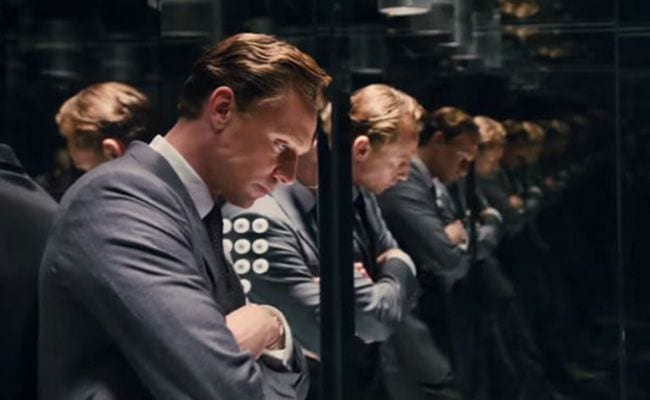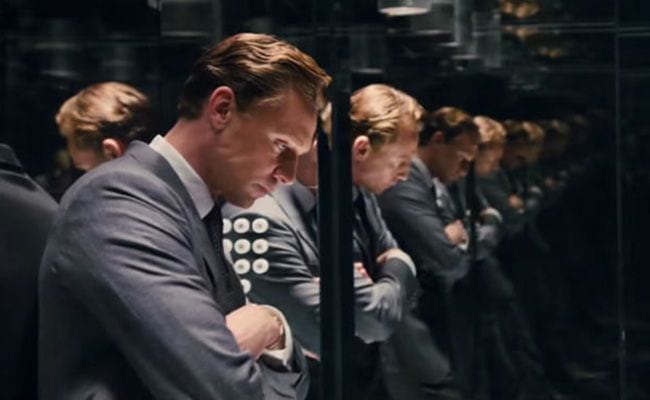
Setting High-Rise in 1975, Ben Wheatley takes full advantage of what we remember from that time, the macramé, matted hairdos, condo living, and marital infidelity. But more important, the movie — based on J.G. Ballard’s bloody skewer of a 1975 novel and now available on VOD in the US — underlines the era’s capacity for antisocial mischief. Without today’s surveillance culture and social media, it’s easier for viewers to swallow the story’s basic conceit, that the inhabitants of a brand new luxury high-rise can, in mere months, whip up a self-contained, brutally violent maelstrom without anybody on the outside being any the wiser.
Laing (Tom Hiddleston) is a forensic pathologist whose numbed indifference to life suits him perfectly not just for his job but also the coterie of white-collar psychopaths who occupy his new apartment building. During a demonstration before a small audience, Laing explains patiently, “The facial mask simply slips off its skull.” It’s not that easy of course, as he goes on to show that the thick pad of skin and muscle need to be separated first from the bone structure underneath by chiseling tools and then a long ripping motion. His performance here is less an educational exercise than a thudding prologue: here’s the beast that lies underneath.
Another of Ballard’s initially standoffish and then easily corrupted men of science, Laing himself is treated like an animal when he moves into the high-rise. It’s the first in a multi-building development rising out of a blasted and wrecked plain somewhere in England, with cantilevered balconies that look suspiciously like rows of caves.
Sunning naked on his balcony, Laing is ogled by the primate just upstairs, Charlotte (Sienna Miller), who tells him later in a bit of post-coital honesty that he looks better with his clothes off. “I was rather expecting to find a level of anonymity,” Laing says when asked why he moved into the building. No luck there, as the blandly handsome bachelor with the murky past (explained only by a few references to a sister who committed suicide) is immediately pitched headlong into the tower’s rumbling slide toward all-out class warfare.
Amy Jump’s screenplay lays out the hints of the combat to come right from the start. Although Laing believes his 25th floor apartment to be just one more cell in the hive, anger over inequality is rife. An invitation up to the 40th floor penthouse to meet the architect Royal, played by an appropriately reptilian yet still somehow aristocratic Jeremy Irons, reveals to Laing a fantasy landscape of gardens and luxuries completely at odds with the sleek yet brutalist cells below.
Down on the lower floors, discontent about inequitable distribution of services ratchets up. It’s a hothouse environment down there, with wife-swap parties already in full swing. Slights like power outages and the closing off of the pool to all lower-floor residents get the already keyed-up lower floor tenants seething about what those above are trying to get away with. It isn’t long before the flash-forward opening scene, in which a grimy Laing is eating a dog, starts to makes a dark kind of sense.
That said, the satire works better in the novel. Like so much of Ballard’s ‘70s work (particularly Concrete Island), this book creates a world of neo-suburban magic realism where minor preoccupations spiral into all-consuming obsessions, mocking the decade’s pretense of a classless society. The movie High-Rise loses context and traction as satirical horror in its slapdash transitions: the building pitches into chaos so swiftly — signaled in a catch-all montage that may as well have been replaced by a silent-film title card reading, “And then everything went to hell” — that the potency of the collapse is all but lost.
As the thin differentiations between these two classes of urban professionals lead quickly to all-out warfare, we might recognize a long tradition of such quasi-Marxist satire, from Bunuel to Monty Python. Like these films, Wheatley’s sets bourgeois propriety against retaliatory ultraviolence. But even as the two classes clash and also come together, the decadent upper floor denizens running into the lower floors’ inhabitants’ ambushes, we see too that both classes take up the fight quickly and eagerly. Nobody thinks of calling the police.
An especially vivid metaphor might be the transformation undergone by Laing’s fellow resident and documentary filmmaker Wilder (Luke Evans), who becomes a brutal participant without blinking an eye, a change barely noticed by his wife, Helen (Elizabeth Moss). Their shift is emblematic: everyone in the building starts out so close to being savages that the switch from economic combat to physical violence is one of method rather than degree.
Wheatley launches a heavy stone of commentary at the end by playing audio of a speech by Margaret Thatcher, the architect of England’s pivot towards a cutthroat brand of capitalist excess. (1975 was the year Thatcher became the first female leader of the Conservatives.) It’s a fair charge — if this was a more reasoned kind of film. But Wheatley spends so little time parsing the roots of the embedded hostilities between the classes (a signature failure for any British filmmaker) that when things fall apart, his movie conveys no sensation of catastrophe or even much awareness.
High-Rise pulls back the skin of civilization from a grim skull beneath with some glee. But all it seems to know to do afterward is play with the blood and gristle.


![Call for Papers: All Things Reconsidered [MUSIC] May-August 2024](https://www.popmatters.com/wp-content/uploads/2024/04/all-things-reconsidered-call-music-may-2024-720x380.jpg)



